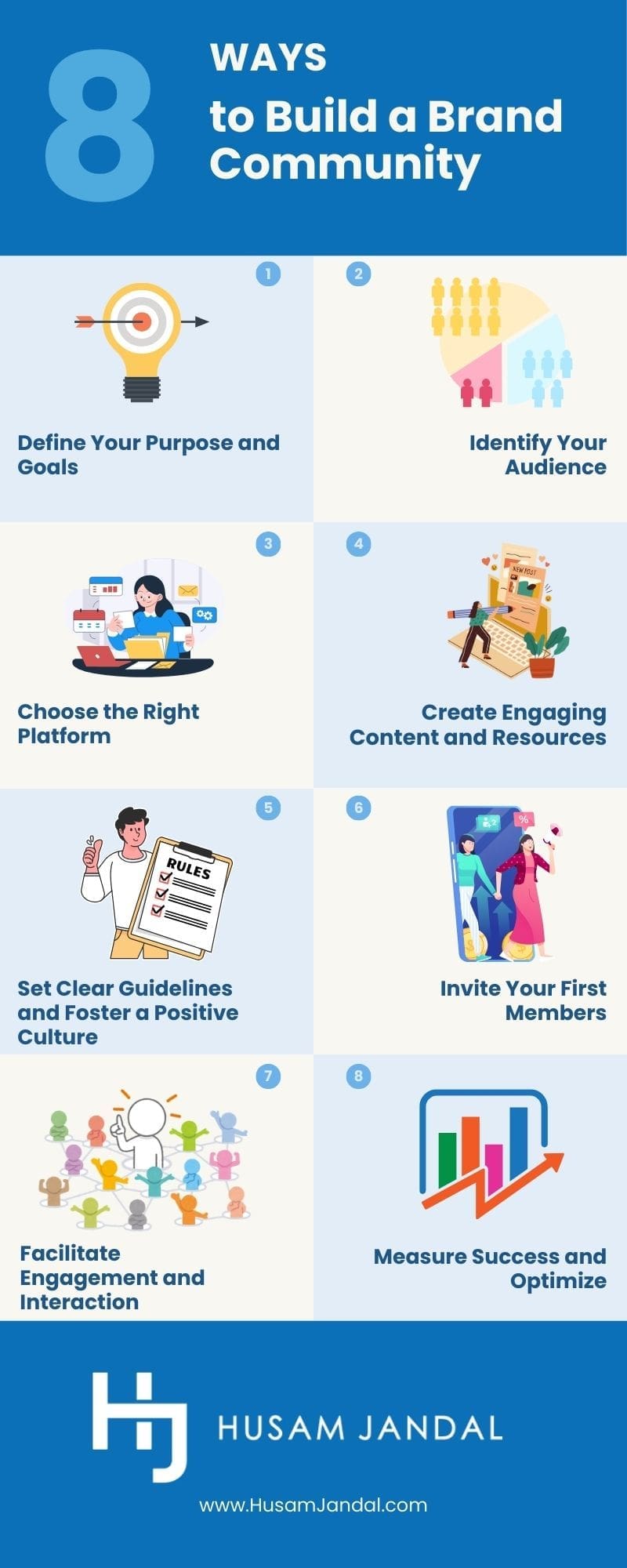 Imagine turning casual buyers into loyal brand ambassadors who not only purchase your products but also passionately promote them within their networks. Picture a space where customers connect, share their experiences, and even collaborate on new ideas for your brand. This isn’t just wishful thinking. It’s the reality of a well-managed online brand community.
Imagine turning casual buyers into loyal brand ambassadors who not only purchase your products but also passionately promote them within their networks. Picture a space where customers connect, share their experiences, and even collaborate on new ideas for your brand. This isn’t just wishful thinking. It’s the reality of a well-managed online brand community.
Brand communities go beyond simple transactions. They build emotional connections and create a sense of belonging that turns one-time buyers into lifelong advocates. From enhancing customer loyalty to providing direct feedback and reducing support costs, these communities are a powerful tool in your brand’s arsenal. In this guide, we’ll explore the essential steps to building and managing a thriving online community that engages your audience and drives real value for your business.
The Basics of Brand Communities
A brand community is a group of people who come together because they share a common interest in your brand, products, or services. This goes beyond just being customers—they actively engage, share experiences, and even advocate for your brand within their networks. Think of it like a club where your brand is the common bond, creating a sense of belonging and loyalty among members.
The Value of Building a Community Around Your Brand
By investing in a brand community, you’re not just creating a space for customer interaction. You’re building a powerful marketing engine that can drive growth, loyalty, and long-term success for your business. Let’s take a quick look at some of the mechanisms behind this.
Enhanced Customer Loyalty
Brand communities foster a deep emotional connection between your business and your customers. Members often feel a personal attachment, which translates to increased loyalty and higher lifetime value. Customers who engage in a brand community spend twice as much as non-members, according to Georgia Tech research. Building this emotional bond is also a key driver in increasing customer stickiness, ensuring that customers remain loyal and continue engaging with your brand over time.
Direct Feedback and Insights
Your community provides a real-time, unfiltered feedback loop. Members will tell you what they love and what they want to see improved, and they will even suggest new ideas. Companies like LEGO have leveraged their community to co-create products, tapping into fan enthusiasm and reducing R&D costs.
User-Generated Content and Brand Advocacy
A thriving community often generates content that promotes your brand organically. Whether it’s reviews, social media posts, or even tutorials, this kind of content acts as free advertising and enhances your brand’s credibility. Think of brands like GoPro or Peloton, where customers eagerly share their experiences, creating a powerful cycle of engagement and promotion.
Reduced Customer Support Costs
Communities can act as an extension of your customer service team. Members often help each other by answering questions, troubleshooting problems, or providing advice. This can go a long way toward reducing support costs for a brand.
Building Trust and Authenticity
A brand community humanizes your business. It’s a space where you can build genuine relationships, showcasing your brand’s personality, values, and commitment to customers. This transparency builds trust, which is crucial given that 81 percent of consumers say trust in a brand to do what’s right is a deciding factor in their purchasing decisions, according to Edelman’s Trust Barometer.
Before You Begin: How to Prepare for Building an Online Brand Community
Before diving in, it’s important to set the right expectations and prepare properly. Many businesses underestimate the resources, time, and commitment required to cultivate a thriving community. By taking a moment to plan and understand the journey ahead, you’ll be better equipped to create a successful, engaged community that delivers real value. The following steps will help you allocate the right resources, set realistic timelines, and ensure you’re ready for the challenges and rewards of community management.
Allocate the Right Resources
Building a community requires dedicated personnel and tools. Consider who will manage day-to-day interactions, create content, and moderate discussions. If your team lacks the capacity, you may need to hire community managers or outsource these roles to ensure consistent management.
Set Realistic Timeframes
Understand that building a vibrant community takes time—often months or even years. Growth will be gradual, so plan for the long game. Avoid rushing the process or expecting immediate results; consistent effort and patience are essential for success.
Commit to Active Management
A community needs constant nurturing. Daily engagement, conflict resolution, and active participation are necessary to keep members interested. Be prepared to dedicate time regularly, whether it’s responding to comments, moderating discussions, or launching new content.
Understand the Importance of Flexibility
Your community’s needs will evolve, and so should your approach. Stay open to trying new engagement strategies, adjusting your content, and even rethinking your platform choice. Flexibility allows you to adapt to member feedback and keep your community relevant.
Prepare for Feedback and Criticism
Communities provide a platform for open dialogue, which can sometimes include criticism. View feedback as a valuable tool for growth. Be ready to handle both praise and criticism constructively, using it to refine your offerings and strengthen member relationships.
Have a Clear Purpose and Plan
Outline your community’s purpose and set clear goals from the start. Whether it’s enhancing customer support, building brand loyalty, or gathering product insights, having a defined mission helps guide your efforts and keeps your community focused and aligned.
Getting Started: How to Build a Brand Community

Building a brand community starts with the idea of creating a space where your customers and fans can connect not just with your business but also with each other. It’s about fostering relationships and turning customers into advocates by engaging them in meaningful ways. A successful brand community is more than just a marketing tool. It’s a long-term strategy that helps your business create value, gain insights, and build loyalty.
Define Your Purpose and Goals
The first step is to identify why you want to build a community. Are you looking to improve customer support, gather product feedback, increase brand loyalty, or something else? Your goals will shape the community’s structure and the kind of content and engagement you promote.
Identify Your Audience
Understand who your ideal community members are. What are their interests, pain points, and motivations? Knowing your audience helps you tailor the community experience to meet their needs, which is crucial for fostering engagement.
Choose the Right Platform
Your choice of platform depends on where your audience spends their time. It could be a Facebook group, a LinkedIn group, a forum on your website, or even a niche platform like Discord or Slack. The key is to choose a space that facilitates interaction and feels natural for your target audience.
Create Engaging Content and Resources
Launch your community with valuable content that speaks directly to your members’ interests. This could include how-to guides, exclusive offers, expert Q&A sessions, or user-generated content. Your content should encourage members to participate, share, and engage.
Set Clear Guidelines and Foster a Positive Culture
Establish community guidelines to set the tone and outline expected behaviors. Make it clear that your community is a safe, respectful space. This step is crucial for building trust and maintaining a healthy environment where members feel comfortable sharing.
Invite Your First Members
Start by inviting your most loyal customers, brand ambassadors, or people who have shown a strong interest in your business. These early members can help set the tone and engage with new members as your community grows.
Facilitate Engagement and Interaction
Encourage members to participate by asking questions, creating polls, hosting events, or sharing behind-the-scenes looks at your brand. Your role as a community manager is to guide the conversation and make sure members feel heard and valued.
Measure Success and Optimize
Track key metrics like member growth, engagement rates, content shares, and feedback to understand what’s working and what needs improvement. Use these insights to fine-tune your approach, ensuring the community remains active and aligned with your goals.
Scaling Up: How to Grow a Brand Community
Growing a community involves expanding your member base and increasing engagement to ensure the community remains vibrant and active. It’s not just about getting more people in the door. It’s about attracting the right members who are genuinely interested in what your brand stands for and who will actively contribute to the community. Growth is fueled by a mix of outreach, engagement strategies, and creating an environment that people want to be part of.
Leverage Your Existing Audience
Start with the people who are already connected to your brand, such as your current customers, email subscribers, and social media followers. Promote your community across all your existing channels and invite these individuals to join. Offering exclusive content or early access to community events can entice them to take that first step.
Create Shareable Content
Content that resonates with your community members can naturally attract new people when it’s shared. Develop engaging and relevant content like infographics, videos, or insightful articles that members will want to share with their networks. The more shareable your content, the more visibility your community gains.
Incentivize Referrals
Encourage your current members to invite friends or colleagues by offering rewards, such as discounts, exclusive access to content, or recognition within the community. Referral programs can be highly effective, as people tend to trust recommendations from peers.
Collaborate with Influencers and Brand Advocates
Partnering with influencers or brand advocates who align with your community values can significantly boost your reach. Influencers can introduce your community to their audience, bringing in new members who are already interested in your niche.
Host Events and Challenges
Virtual events, webinars, or challenges create buzz and provide value to members while attracting newcomers. These activities give people a reason to join, engage, and stay active in your community. For instance, brands like Peloton regularly host challenges that not only engage current members but also draw in new participants eager to join the fun.
Optimize Your Onboarding Process
The first impression matters. Make sure new members feel welcome and understand how to engage with the community right away. A smooth onboarding process with clear guidance, welcome messages, and a tour of key features helps newcomers feel comfortable and eager to participate.
Promote Across Multiple Channels
Consistently promote your community on social media, in newsletters, and on your website. Highlight the benefits of joining and use testimonials from current members to show the value of being part of your community.
Engage with Your Community Regularly
Consistent interaction from you or your community managers helps keep the conversation lively and encourages members to stay active. When your community feels like a dynamic, engaging place, it naturally attracts more people.
Ongoing Needs: How to Manage a Brand Community
Managing a brand community involves maintaining an active, healthy, and positive environment that keeps members engaged and aligned with your brand’s values. It’s about nurturing relationships, facilitating conversations, handling conflicts, and ensuring that the community remains a welcoming space where members feel valued. Effective management turns a group of followers into a thriving, engaged community that supports your business goals.
Establish and Enforce Community Guidelines
Clear rules help set expectations for behavior and content. These guidelines should promote respect, inclusivity, and constructive engagement. Regularly remind members of these rules, and be consistent in enforcing them to maintain a positive atmosphere.
Provide Active Moderation
Moderation is key to managing a community. This includes monitoring discussions, addressing inappropriate behavior, and keeping spam or off-topic content in check. Active moderation ensures the community stays focused and that members feel safe participating.
Foster Meaningful Community Engagement
Encourage conversations by asking thought-provoking questions, highlighting member contributions, and facilitating discussions around relevant topics. This isn’t just about keeping the conversation going. It’s about ensuring the interactions are meaningful and add value to the community.
Respond Promptly to Member Feedback and Concerns
Be attentive to the needs of your members. Address questions, feedback, or complaints quickly and respectfully. When members see that their voices are heard, it strengthens their connection to the community.
Recognize and Reward Active Members
Recognizing your most engaged members can go a long way in maintaining activity and morale. Highlight top contributors, celebrate member milestones, or offer special perks for active participation. Recognition fosters a sense of belonging and motivates others to engage.
Adapt and Evolve with Your Community
A successful community manager stays tuned in to the changing needs and interests of the group. Use feedback and analytics to adjust your content, activities, and strategies. Communities evolve over time, and adapting ensures they stay relevant and valuable.
Leverage Community Insights for Continuous Improvement
Use analytics to track engagement metrics like active members, post frequency, and response rates. These insights help you identify what’s working and where improvements are needed, allowing you to fine-tune your management approach.
Facilitate Peer-to-Peer Interaction
While your role is to guide the community, the most successful groups are those where members interact directly with each other. Encourage peer-to-peer support by promoting member-led discussions, Q&A sessions, or spotlighting user-generated content.
Plan Regular Content and Activities
Keeping a consistent flow of content, such as weekly discussions, AMAs (Ask Me Anything), or themed days, helps maintain a rhythm that members can look forward to. Planned activities keep the community vibrant and prevent it from going stagnant.
Be Prepared for Crisis Management and Conflict Resolution
Occasionally, conflicts or issues will arise. As a manager, it’s important to address these situations calmly and fairly, using clear communication to resolve problems. A proactive approach to conflict management helps maintain harmony and trust within the community.
Analysis: How to Measure Success in Your Online Community Strategy
Measuring success in your online community is about assessing whether the community is achieving your goals and providing value to both your brand and its members. This involves tracking key metrics, gathering insights, and using data to guide your decisions and optimize your community strategy. By regularly measuring success, you can identify what’s working, make informed adjustments, and ensure the community continues to thrive and support your broader business objectives.
Define Your Key Performance Indicators (KPIs)
Start by identifying the specific metrics that align with your community goals. Common KPIs include member growth, engagement rates, active participation, content shares, and customer satisfaction. For instance, if your goal is to boost customer support, measuring the reduction in support tickets handled by your team due to community self-help could be a key indicator.
Track Member Growth and Retention
Monitor how many new members join the community over time and how many stay active. High growth rates combined with strong retention indicate a healthy community that attracts and engages people. On the other hand, low retention rates might signal issues with onboarding or engagement that need addressing.
Analyze Engagement Levels
Engagement metrics like the number of posts, comments, likes, and shares reveal how active your community is. High engagement shows that members are finding value and participating, while low engagement might indicate the need for more relevant content or improved interaction strategies.
Monitor Content Performance
Identify which types of content generate the most interaction. Are Q&A sessions, tutorials, or user-generated content driving the most engagement? Understanding what resonates with your audience helps you refine your content strategy and produce more of what your members value.
Measure Member Satisfaction and Sentiment
Use surveys, polls, or feedback forms to gauge member satisfaction. Sentiment analysis tools can also help you understand the overall mood of your community by analyzing the tone of the discussions. Positive sentiment and high satisfaction levels suggest that the community is meeting its members’ needs.
Evaluate Impact on Business Goals
Link community performance to your broader business objectives. For example, if one of your goals is to increase brand loyalty, measure how many community members are repeat customers or how often they refer others. You can also track how the community influences conversion rates and customer lifetime value or reduces churn.
Assess Response and Resolution Times
If your community plays a role in customer support, measure how quickly member questions are answered and issues are resolved. Faster response times typically improve member satisfaction and reduce the load on your traditional support channels.
Analyze Peer-to-Peer Interaction

A thriving community often has strong peer-to-peer interactions. Track how often members are helping each other without direct involvement from your team. This indicates a healthy, self-sustaining community and reduces your need to manage every conversation.
Monitor Community Health Metrics
Metrics like the ratio of active to inactive members, time spent in the community, and repeat visit rates help gauge overall community health. Healthy communities see consistent interaction and returning members who find ongoing value.
Adjust Based on Insights
Use the data you gather to make strategic adjustments. If engagement drops, experiment with new content types or interaction methods. If growth slows, revisit your outreach and promotion strategies. Continual measurement and optimization keep the community aligned with your goals.
Common Mistakes When Creating, Growing, and Managing Brand Communities and How to Avoid Them
Brands often dive into building, growing, and managing online communities with great intentions, but it’s easy to stumble along the way. The process is more complex than just setting up a group and waiting for engagement; it requires careful planning, consistent management, and a keen understanding of your audience. Many brands make common mistakes that can hinder community success, from neglecting member engagement to setting unclear goals. By identifying these pitfalls and learning how to address them, you can set your brand community up for sustained growth and impact.
Lack of Clear Goals and Purpose
Many brands launch a community without a clear purpose or set goals. This leads to unfocused content, scattered engagement, and difficulty measuring success.
Be sure to define your community’s purpose upfront. Are you aiming to provide customer support, gather feedback, foster brand loyalty, or something else? Set specific, measurable goals to guide your strategy. Regularly revisit these goals to ensure they align with your brand’s evolving needs.
Choosing the Wrong Platform
Selecting a platform that doesn’t align with your audience’s preferences can limit engagement. For instance, launching a community on LinkedIn when your audience prefers Discord can create a disconnect.
Research where your target audience spends their time and choose a platform that fits their habits and communication style. Test different platforms if needed, and don’t be afraid to pivot if you find a better fit later on.
Focusing on Quantity Over Quality
Brands often prioritize growing their community numbers rather than nurturing active and engaged members. This can lead to a large but inactive community.
Focus on quality engagement rather than just adding members. Create meaningful content that resonates with your audience and fosters interactions that add value. Encourage deeper connections rather than superficial growth.
Neglecting Community Management
A community without active management can quickly become disorganized or toxic, driving away valuable members. Brands sometimes set up communities and then “leave them on autopilot,” expecting them to manage themselves.
Appoint dedicated community managers who can facilitate discussions, moderate content, and keep the atmosphere positive and on-brand. Regularly engage with your members, address conflicts promptly, and ensure the community remains a welcoming space.
Ignoring Member Feedback
Overlooking feedback can make members feel unheard, leading to disengagement. Communities thrive on interaction, and ignoring what your members are saying is a missed opportunity to improve.
Actively solicit feedback through polls, surveys, and open discussions. Use this feedback to make adjustments to your content, community guidelines, or even your products. Show members that their opinions matter by acknowledging their input and making visible changes when possible.
Inconsistent Engagement and Content Posting
Irregular posting or inconsistent engagement from community managers leads to a drop in member activity. When content is sporadic, members are less likely to return regularly.
Develop a content calendar to ensure a steady flow of posts, discussions, and events. Consistency helps build anticipation and keeps the community lively. Even simple actions, like responding to comments promptly, can maintain momentum.
Not Setting or Enforcing Community Guidelines
Without clear rules, communities can quickly become chaotic or hostile, turning members away. Unclear or unenforced guidelines leave room for spam, trolling, and negative interactions.
Establish clear community guidelines that outline acceptable behavior, and consistently enforce them. Be transparent about the consequences of breaking rules, and maintain a firm but fair approach to moderation.
Failing to Measure Success and Optimize
Brands that don’t track community performance struggle to understand what’s working and what isn’t. This often leads to stagnant growth or missed opportunities.
Regularly track key metrics, such as engagement rates, member retention, and satisfaction levels. Use these insights to adjust your strategy, experiment with new content, and continuously optimize your approach.
Over-Promotion and Sales-Driven Content
Communities that feel like constant sales pitches can quickly lose their appeal. Members join for value and interaction, not just to be sold to.
Focus on providing value first. Share knowledge, facilitate discussions, and create content that benefits your members. Keep promotional content minimal and always frame it in a way that aligns with the community’s interests.
Not Adapting to Community Evolution
Communities evolve over time, and what worked in the beginning might not work as the group grows. Sticking to the same tactics can lead to stagnation.
Stay attuned to the community’s needs and be flexible in your approach. Regularly ask what your members want more of, and be prepared to pivot your strategy to keep the community fresh and engaging.
Get Help Building and Managing Your Online Brand Community
Bigger brands often have one or more dedicated community managers to oversee all the tasks involved in building a thriving community. However, a talented and experienced social media manager can often fulfill both roles for small and midsized companies, particularly with the guidance of a seasoned chief marketing officer (CMO) or marketing strategist. This is the approach I typically take as I begin building the online footprint for the brands I serve as a digital marketing consultant. It may involve working with existing in-house talent or helping you find the right talent to ensure your brand’s voice is heard and your community thrives, then establishing the framework to fulfill the needs of your growing community. If you’d like to discuss developing a comprehensive digital marketing strategy, including community growth and management, contact me for a complimentary consultation.
FAQs on Building, Growing, and Managing an Online Brand Community
How can building a community around your brand enhance your online brand presence?
A brand community amplifies your online brand presence by creating continuous engagement and authentic interactions around your brand. Active communities generate buzz, increase social media mentions, and drive more traffic to your website. They also provide valuable content and testimonials that enhance your brand's visibility and credibility in search results.
What are the common mistakes brands make when growing their online communities?
Common mistakes include neglecting community management, focusing on numbers over engagement, ignoring feedback, and over-promoting products. Brands often fail to set clear goals or choose the wrong platform, leading to low participation. Address these by setting clear guidelines, actively moderating, focusing on value-driven content, and regularly adjusting strategies based on member feedback.
How do you effectively manage a brand community to keep members engaged?
Effective community management involves active moderation, consistent engagement, and fostering peer-to-peer interactions. Set clear guidelines to maintain a positive environment, respond promptly to feedback, and recognize active members. Regularly create engaging content, facilitate discussions, and host events or challenges to keep the community vibrant and members motivated to participate.
What are the first steps in building a community around your brand?
Start by defining your community’s purpose and setting clear goals. Identify your target audience and choose the right platform where they already engage. Develop content that provides value, such as tips, discussions, or exclusive offers. Invite initial members from your existing audience and ensure a welcoming onboarding experience to foster early engagement.
How does an online brand presence impact the success of a brand community?
A strong online brand presence builds credibility and attracts members to your community. It helps position your brand as an authority and enhances discoverability through search engines and social media. Consistent, quality content across your digital platforms encourages community interaction, driving more members to join and actively engage.
What metrics should you track to measure the success of your brand community?
Key metrics include member growth, engagement rates (likes, comments, shares), retention, satisfaction scores, and response times. Analyzing peer-to-peer interactions and content performance also provides insights into community health. Connecting these metrics to broader business goals, like increased sales or reduced support costs, helps measure overall community impact.
How can a community manager improve the online brand presence of a community?
A community manager enhances online brand presence by fostering engagement, creating valuable content, and maintaining a positive, active space. They can highlight user-generated content, host interactive sessions, and consistently reinforce your brand’s values. Effective community management ensures your brand remains visible, trustworthy, and relevant to its audience.
What strategies help in growing a brand community successfully?
To grow a brand community, leverage existing audiences, create shareable content, and encourage referrals. Collaborate with influencers, host engaging events, and maintain consistent communication. Optimize onboarding processes to welcome new members and promote your community across all digital channels to attract the right audience and sustain growth.
How can feedback from your community strengthen your online brand presence?
Community feedback provides direct insights into what your audience values, enabling you to improve products, services, and content. By acting on feedback, you show members their opinions matter, fostering loyalty. Positive changes driven by feedback can lead to organic word-of-mouth promotion, enhancing your brand’s reputation and online presence.
Are a community manager and social media manager the same thing?
No, a community manager and a social media manager have distinct roles. A social media manager focuses on managing your brand’s social media profiles, creating content, and handling day-to-day posting, often aimed at broader marketing and engagement. In contrast, a community manager nurtures relationships within your community, engaging directly with members, moderating discussions, and fostering a positive environment. While social media managers build brand awareness, community managers cultivate deeper, ongoing relationships with your audience, ensuring that your community remains active, supportive, and aligned with your brand’s values. Both roles are essential but serve different purposes in managing your brand’s online presence.
Can a social media manager perform the role of a community manager?
Yes, a social media manager can perform the role of a community manager, especially in smaller organizations where roles often overlap. However, while the skills are complementary, the focus differs. Social media managers are typically tasked with content creation, scheduling, and broader brand messaging, whereas community managers are more hands-on with member engagement, conflict resolution, and building deeper relationships. If a social media manager takes on community management duties, they need to prioritize direct interaction, active moderation, and fostering a sense of belonging within the community. Balancing both roles can be challenging, so it’s important to ensure that neither responsibility is neglected, especially as your community grows and requires more dedicated attention.





































































